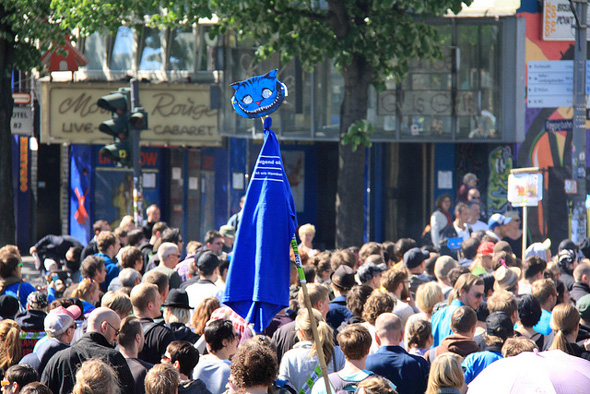-
As Urbanization Accelerates, Policymakers Face Integration Hurdles
August 31, 2012 By Blair A. Ruble
The challenges for cities in the coming century will be many, but accounting for swelling numbers of new residents – due to more open avenues of communication and flows of goods, economic opportunity, population growth, and potential climate change-induced displacement – is perhaps the biggest.
While cities always have received migrants, the development of increasingly mobile populations on a previously unknown scale comprises a new urban reality. As cities around the world have become home to the majority of human beings, they have evolved into agglomerations of neighborhoods defined by ethnicity, religion, or nationality. Creating inclusive and socially sustainable cities in this context requires a strong democratic civic culture; urban policymakers must pay close attention to the ways neighborhoods and local governments interact to forge community, foster economic and educational opportunities, and provide services.
While the large-scale rapid movement of people is happening globally, the process by which migrant communities are incorporated into a particular urban region varies from city to city. The history of place, community identities, and public policy all impact this process. Therefore, rather than make specific policy recommendations I would suggest that developing effective policies must begin with the promotion of new sensibilities about what these policies should be.
To be successful and avoid conflict in a time of rapid global population movement, a city must simultaneously accept both different and shared points of reference. Local legends, memories, and telling of history must go beyond exclusionary understandings of society and embrace an inclusive pluralism. In other words, urban civic identities must encompass a variety of urban groups and individuals. Even if they have been divided in the past, cities must somehow create a shared sense of responsibility for a common future.
Cities – the center of changing patterns of interconnections – are inevitably diverse. Therefore cities must strive to provide protected public meeting places in which people of difference interact with one another, incorporating their multiple histories of space, place, and identity. Public space and public domain (both literal and figurative) must be both shared and protected.
As sociologist Daniel A. Bell recently argued at a Comparative Urban Studies Project event on “The Spirit of Cities,” the distinctive ethos of a particular city creates an important shared sense of community in otherwise divided cities. Sometimes, the process of nurturing a shared sense of place and community emerges from mundane, everyday life activities. Many Chicagoans of all races and classes identified with Marshall Field’s Department Store as a central element of living in the city; a reality which became most apparent after Macy’s had taken over the store. Local food – New Delhites like to eat kulki by India Gate on summer nights – allows people who otherwise assume they share little to find common ground. Sports teams similarly bring people together across otherwise meaningful divides.
At other times, shared meaning can emerge from public protection of places used by all sorts of different people. Specialists writing about Montreal’s extensive networks of parks, for example, have commented on how migrants, Anglophones, and Francophones all use the same park space with ease even if they do not necessarily mingle with each other. Such sharing of a space can be an important first step towards something more meaningful.
Similarly, while commenting not long ago on the emergence of Washington, DC’s U Street area, Jamal Muhammad, community elder, jazz historian, and radio personality, observed that while people of different races and ethnicities coexist along today’s U Street without commingling, such coexistence might be a first step toward something new.
“One day,” he suggests, “there will be real diversity, and people will frequent the area and color won’t matter. We will all just hang out because we have the same interest.”
In other words, seemingly trivial aspects of everyday life may not be trivial at all when it comes to nurturing a broad umbrella of social identity that encompasses many competing identities. Policymakers need to build on these moments in their efforts to nurture shared identity.
There can be no “quick fixes”: approaches must be complex, incremental, and presumed to require persistence and time for success. The challenge for policymakers thus becomes how to expand the economic and social space for migrants while balancing conflicting assumptions about the appropriateness of specific policies.
The complexity of the challenges faced by cities with new migrant communities thus demands we appreciate that a city is subject to constant renegotiation. Residents and businesses constantly seek to re-establish the boundaries of the local social, economic, political, cultural, and linguistic landscapes. Responses must be fluid policies, rather than starkly posed regulations that favor black-and-white distinctions.
This sensibility is more difficult to sustain than one might think. Moral relativism offends those who feel that they have played by the rules of the game, only to lose to those using a different set. This tension is why there must be both shared general assumptions and flexible individual policies. Otherwise, the complexities of migration and urbanization in a rapidly changing world can simply overwhelm local policymakers.
Blair A. Ruble will be one of the official U.S. delegates to UN-HABITAT’s sixth World Urban Forum next week in Naples.
Photo Credit: Euro May Day 2011, courtesy of flickr user Rasande Tyskar.
Topics: adaptation, development, economics, India, livelihoods, migration, security, U.S., urbanization
 A Publication of the Stimson Center.
A Publication of the Stimson Center.






